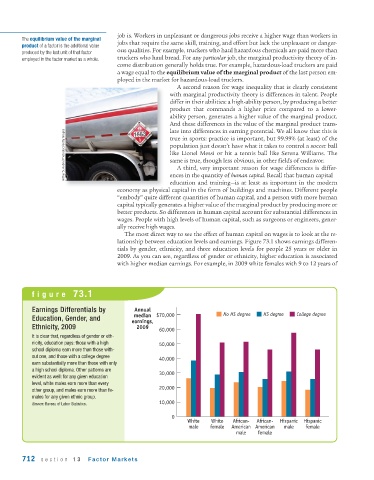Page 754 - Krugmans Economics for AP Text Book_Neat
P. 754
job is. Workers in unpleasant or dangerous jobs receive a higher wage than workers in
The equilibrium value of the marginal
jobs that require the same skill, training, and effort but lack the unpleasant or danger-
product of a factor is the additional value
ous qualities. For example, truckers who haul hazardous chemicals are paid more than
produced by the last unit of that factor
employed in the factor market as a whole. truckers who haul bread. For any particular job, the marginal productivity theory of in-
come distribution generally holds true. For example, hazardous-load truckers are paid
a wage equal to the equilibrium value of the marginal product of the last person em-
ployed in the market for hazardous-load truckers.
A second reason for wage inequality that is clearly consistent
with marginal productivity theory is differences in talent. People
differ in their abilities: a high-ability person, by producing a better
product that commands a higher price compared to a lower-
ability person, generates a higher value of the marginal product.
And these differences in the value of the marginal product trans-
Arthur S. Aubry/Photodisc/Getty Images population just doesn’t have what it takes to control a soccer ball
late into differences in earning potential. We all know that this is
true in sports: practice is important, but 99.99% (at least) of the
like Lionel Messi or hit a tennis ball like Serena Williams. The
same is true, though less obvious, in other fields of endeavor.
A third, very important reason for wage differences is differ-
ences in the quantity of human capital. Recall that human capital—
education and training—is at least as important in the modern
economy as physical capital in the form of buildings and machines. Different people
“embody” quite different quantities of human capital, and a person with more human
capital typically generates a higher value of the marginal product by producing more or
better products. So differences in human capital account for substantial differences in
wages. People with high levels of human capital, such as surgeons or engineers, gener-
ally receive high wages.
The most direct way to see the effect of human capital on wages is to look at the re-
lationship between education levels and earnings. Figure 73.1 shows earnings differen-
tials by gender, ethnicity, and three education levels for people 25 years or older in
2009. As you can see, regardless of gender or ethnicity, higher education is associated
with higher median earnings. For example, in 2009 white females with 9 to 12 years of
figure 73.1
Earnings Differentials by Annual
median $70,000 No HS degree HS degree College degree
Education, Gender, and
earnings,
Ethnicity, 2009 2009 60,000
It is clear that, regardless of gender or eth-
nicity, education pays: those with a high 50,000
school diploma earn more than those with-
out one, and those with a college degree 40,000
earn substantially more than those with only
a high school diploma. Other patterns are 30,000
evident as well: for any given education
level, white males earn more than every
other group, and males earn more than fe- 20,000
males for any given ethnic group.
10,000
Source: Bureau of Labor Statistics.
0
White White African- African- Hispanic Hispanic
male female American American male female
male female
712 section 13 Factor Markets

